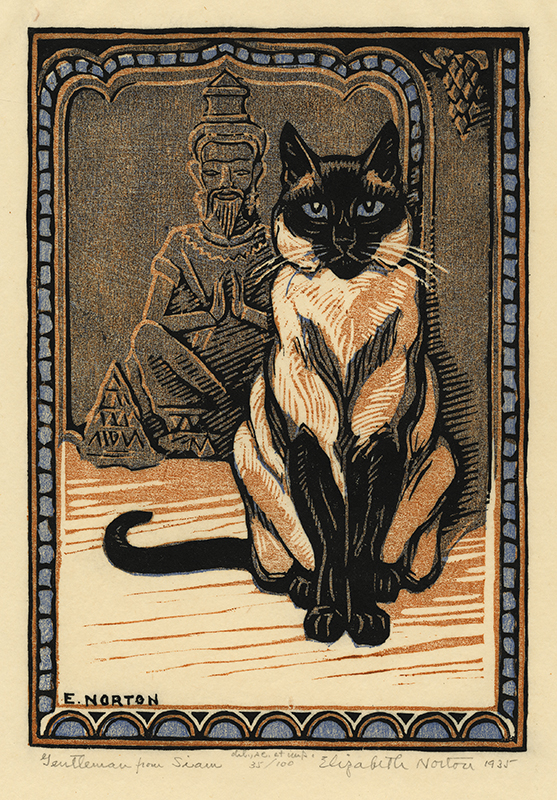Gentleman from Siam is a color linocut from 1935 by American artist, Elizabeth Norton. It is pencil signed, dated, and titled in the lower margin. Norton proclaimed with the pencil inscription “del., sc. et imp.” that she designed the image, and carved and printed her matrixes. Gentleman from Siam is editioned 35/100. It is printed on very fine, ivory Japanese paper and the image measures 8-1/4 x 5-3/4 inches.
Norton’s subject matter was often animals and she explained, “I never would play with dolls. I just liked anything alive—whether it was crickets or grasshoppers, lizards or dogs or cats or horses…. The Lincoln Park Zoo in Chicago was a second home to me when I was young. I used to go and feed the elephants as a small child.” As she became more proficient at painting, the zoo superintendent allowed her to go inside the barrier between the crowds and cages. She later mused, “I spent a lot of time in the lion house. I was crazy about lions, and the superintendent often let me pet their best lion, Leo, and carry some of the lion cubs.”
Elizabeth Sawyer Norton, painter, printmaker, sculptor, and ceramist, was born in Chicago, Illinois on December 16, 1887. Her father, James S. Norton, was a noted attorney who provided his family a comfortable home in Chicago’s North side and a house, Summer Haven, at Lake Geneva, Wisconsin. Norton’s father died in 1909 and thereafter her family lived in Chicago, New York City, and Williamstown, Massachusetts. She first studied at the School of the Art Institute of Chicago. In New York, Norton studied at the Art Students' League, the National Academy of Design, the Parsons School of Design, and the School of American Sculpture.
A newspaper article on Norton explained that she ran a surgical dressing workroom in New York from 1914 to 1918 for the French soldiers as the United States had not entered the war. She traveled to California in 1915 to see the Panama Pacific International Exposition in San Francisco and returned in 1919 to make the city of Palo Alto, in the San Francisco Bay Area, her home. As sculpting had become too physically difficult for her, Norton began printmaking in 1922 and she produced etchings, drypoints, color block prints, and lithographs.
Norton was instrumental in the founding of the Palo Alto Arts Club in 1921. She was a member of and exhibited with the California Society of Etchers, the California Printmakers, the Prairie Printmakers, the Woodcut Society, the American Federation of Arts, and the San Francisco Society of Women Artists. In 1930, Norton was included in the Fourth Annual Exhibition of American Block Prints, organized by the Philadelphia Print Club, held at the Brooklyn Museum. Her work was also shown in the 1939 Golden Gate International Exposition and she had a solo exhibition at the California State Library in 1942.
Norton’s work is represented in the collections of the Fogg Art Museum, Harvard University and the Massachusetts Institute of Technology, Cambridge; the Art Institute of Chicago, Illinois; the Nelson Atkins Museum of Art, Kansas City, Missouri; the Currier Museum of Art, Manchester, New Hampshire; the American Museum of Natural History, the Metropolitan Museum of Art and the New York Public Library, New York; the Fine Arts Museums of San Francisco, California; and the Library of Congress, Washington, D.C.
Elizabeth Norton died in Palo Alto, California on 6 August 1985.



